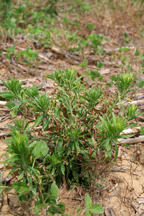Purdue, Ohio State partner to help farmers control marestail
December 3, 2013
 |
|
A marestail weed regrows after glyphosate application. Marestail, or horseweed, has become increasingly problematic for Indiana and Ohio soybean growers because it is resistant to common herbicides. (Purdue Weed Science photo/Bill Johnson) |
WEST LAFAYETTE, Ind. - Purdue and Ohio State University Extension have partnered to publish a new fact sheet aimed at helping farmers battle herbicide-resistant marestail and its yield-reducing affects on soybeans.
Marestail, also referred to as horseweed, primarily emerges in late summer into fall and again from late-March through June in both Indiana and Ohio. The weed competes with soybean plants for soil nutrients, space and water. Mature marestail also can hinder soybean harvest, and it doesn't respond to treatment from one of the most commonly used herbicides.
"Most populations of marestail in Ohio and Indiana are resistant to glyphosate, and will not be controlled by burndown or post-emergence applications of glyphosate alone," said Mark Loux, Ohio State Extension weed scientist.
Glyphosate resistance means farmers need to pay extra special attention to herbicide application timing so they can try to control marestail during early growth stages when it's most treatable. It also means soybean growers likely will need to use a cocktail of other herbicides to achieve marestail control.
Loux and Purdue Extension weed scientist Bill Johnson hope to make navigating marestail control a little bit easier with their new fact sheet, "Control of Marestail in No-Till Soybeans," which is available for free download at either of the following websites:
* Purdue Extension Weed Science - http://www.btny.purdue.edu/weedscience
* OSU Extension Weed Science - http://agcrops.osu.edu/specialists/weeds
The fact sheet includes information about marestail biology, soybean yield loss, herbicide resistance and steps for controlling and managing the weed.
"We continue to struggle with marestail control, so we need to emphasize that it's a multistep process," Johnson said. "Soybean growers need to plan a two-pass burndown system with an application in fall followed by another in spring, or an application in early spring followed by another at planting.
"Burndown treatments have to be done before soybeans emerge. Once soybeans emerge, it's too late."
In addition to the problems with herbicide resistance, marestail is hard to control because it reproduces easily and quickly. According to Johnson and Loux, marestail plants can produce up to 200,000 seeds that are transported by wind, spreading herbicide-resistant populations.
The plant is most easily controlled when it's still in the seedling or rosette stage, so farmers need to apply burndown herbicides before marestail reaches the stem elongation period. The weed overwinters in the rosette stage and remains there through late April when stem elongation, or bolting, starts.
Marestail can grow to heights of 3-6 feet and plants that emerge in the fall will start bolting earlier than the spring-emerging plants, Johnson said. But it's the spring-emerging plants that cause the most problems for many eastern Corn Belt soybean producers.
"Spring-emerging marestail has been the most problematic to manage in the southern half of Ohio and Indiana - especially the plants that emerge in May and June," he said.
Writer: Jennifer Stewart, 765-494-6682, jsstewar@purdue.edu
Sources: Bill Johnson, 765-494-4656, wgj@purdue.edu
Mark Loux, 614-292-9081, loux.1@osu.edu
Ag Communications: (765) 494-2722;
Keith Robinson, robins89@purdue.edu
Agriculture News Page

